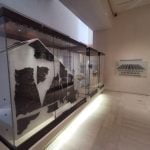Chapters
Tents were already in use in ancient times. Ancient Romans used them mainly in marching camps (castra aestiva), which were broken up during military campaigns every day. We owe a lot of information about their construction to the excavations in Vindolanda, near Hadrian’s Wall in England, where leather materials have also been preserved.
Information about the use of tents by the Romans in war is also provided by the reliefs from Trajan’s Column in Rome, where selected moments are presented Dacian war.
Tent of contubernium
Tents are primarily associated with contubernium – the smallest organized unit in the Roman army, which consisted of eight legionaries. The soldiers of such a unit were called contubernales. In fact, there were two additional people in the unit – servants or slaves who were in charge of packing or cooking. Officially, however, they were not included in the unit. It is worth mentioning that the soldiers participating in the campaign were referred to as sub pellibus (“under the skin”) because of the leather tents in which they stayed.
Each contubernium had its own tent, which was approximately 3 meters wide and 1.5 meters high. The tent was transported by a mule assigned to the unit. The animal carried on its back: two tent poles, a folded leather tent, pegs, ropes, two baskets (used to dig a camp ditch), digging tools, a small stone grain mill to grind the grain, and extra food.
As mentioned, the tent could fit up to 10 people and clothes or other useful things that had to be protected from the rain. Other items and weapons were located behind the tent. There were a lot of contubernia tents, so they were attached tightly to each other in the camp. The centurion tents were lined up in a row, and at the end was a centurion’s tent of relatively similar dimensions.
Tent of officers
The officers’ tents were the same width, but were taller and allowed the centurions to stay upright (2.4 meters high). Due to their height, the centurion tents required more space as the securing ropes had to reach the ground further.
Tent of commanders
The tents where the command staff stayed and slept were much larger. The width of such a tent was about 3.5 m wide and over 3.6 m high. Moreover, such tents had equipment and facilities unavailable to soldiers. The heavy leather cover and long support poles required two or more mules and a wagon.








